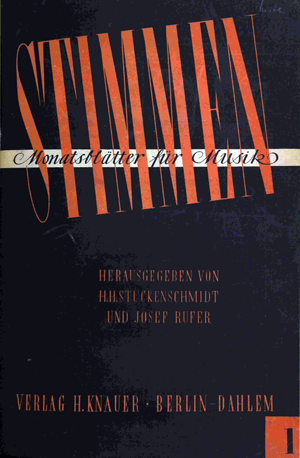Stimmen: Monatsblätter für Musik
Prepared by Alexander Staub
Online only (2020)

Between November 1947 and the beginning of 1950 nineteen issues of the journal Stimmen: Monatsblätter für Musik (STM) were published by H. Knauer in Berlin-Dahlem. Subtitled Offizielles Organ der Internationalen Gesellschaft für Neue Musik, Sektion Deutschland, the periodical was jointly edited by Hans Heinz Stuckenschmidt and Josef Rufer. Individual issues were grouped into three annual volumes, although the numbers were not always clearly marked. In the first three issues, November 1947 to January 1948, the publication month was clearly noted, while subsequent issues were dated with the year only. Occasional double issues were published; generally the interval between issues seems to have been between one and three months. The first publication year consisted of issues nos. 1 (1947) to 11/12 (1948) and the second contained nos. 13/14 to 18 (1949). After the appearance of only one issue in the third year, no. 19 (1950), the periodical ceased abruptly, although the editors announced the forthcoming table of contents for 1949 was to appear in the never-published issue no. 20.
The scope and layout of the Stimmen remained the same throughout the time of publication. With covers designed by Jürgen Freese in alternating colors, each issue comprised some 30 pages. The journal’s objectives were defined by Stuckenschmidt and Rufer in the two introductory essays “Maßstäbe” (Standards) and “Musik denken lernen” (Learning to think (about) music), with a focus on new music, especially with regard to its individual and social functions, its development and orientation after the two world wars and the exchange between music theory and performance.
The particular significance of Stimmen lies in the periodical’s enlightened approach and in the advancement of a reorganization and reorientation of music in Germany after the Second World War. This noble goal was supported in the years 1948 and 1949 by cultural exchange – fostered by the Office of Military Government for Germany (OMGUS) – of German students, persons in leading positions, specialists, and particularly by Stuckenschmidt’s travels to the United States and within the American Zone of Occupation. Stuckenschmidt saw Stimmen as a cultural ambassador, noting with pleasure that the “hermetic seal of Germany during the war years” eased with performances of top American, English, French and Russian artists.
Individual issues opened with essays on a variety of musical topics that were either self-contained or taken from a larger context. These were followed by the section “Stimmen des In- und Auslandes” (Opinions from here and abroad), which presented in-depth reports on musical activities in various cities, critical reviews of frequently-first performances and various illustrations (photographs, stage settings) and musical examples. The review section “Neue Noten und Bücher” (Newly sheet music and books) containing detailed descriptions of a variety of new editions was followed by “Notizen” (Notes) with brief communications from the world of music in general and especially the Internationale Gesellschaft für Neue Musik, Sektion Deutschland (International Society for Contemporary Music, German Section). “Werke von […]” (Works by …) provided simple work catalogs serving as surveys of the oeuvres of Křenek, Schoenberg, Gurlitt, Blacher, Shostakovich and others. “Musiker-Adressen” (Adresses of musicians) facilitated contacts and networking among the readers, and “Unsere Autoren” (Our authors) presented concise biographical information. Only the issues of the first year contained a section with concert announcements, advertisements of new publications and recordings as well as “Klein-Anzeigen” (Classified advertisements) – miscellaneous posts concerning available jobs and the purchase and sale of scores and instruments.
The list of contributors is like a “Who’s Who” of contemporary musicology and performance. While the main authors were editors Stuckenschmidt and Rufer; both were personally acquainted with numerous, often avant-garde composers of the time their contributions to contemporary music. Frank Martin and Klaus Pringsheim wrote on the role of the composer and social responsibility. Many well-known figures reported on music in their respective countries, including Aaron Copland on the United States, Max Brod on Palestine/Israel, Carleton Sprague Smith on Brazil, and Pringsheim on Siam (Thailand), Japan, and Hollywood. Arnold Schoenberg, Ferruccio Busoni, Olivier Messiaen, Ernst Krenek, George Antheil and Edgar Varèse contributed thoughts on the compositional process and their own works. Musicology was represented in articles by Wilhelm Furtwängler, Ernst Krause, Willi Apel and Hellmuth Christian Wolff. Peter Wackernagel contributed the only essay spread over several issues, dedicated to the handwriting of composers of the 18th to 20th centuries. Further renowned contributing authors that should be mentioned are Hermann Scherchen, Adolf Loos, Iwan Iwanowitsch Sollertinski, Otto-Erich Schilling, Dusan Pandula, Bernd Alois Zimmermann and Werner Egk.
This RIPM Index was produced from a copy of the journal held by the Sibley Library of the Eastman School of Music in Rochester, New York.
